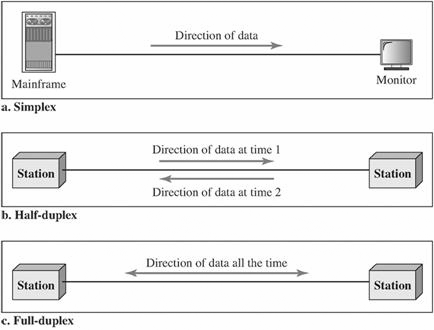In a transportation network, we transport goods. In a computer network, we transport data, so we study data communications, and how data are transmitted from one computer and received by another.
In a transportation network, traffic can move in two directions between a sender and a receiver. In Hong Kong, most roads carry two-way traffic, but there are some roads that allow only one-way traffic. If there is roadwork in progress, a single lane may be shared between up and down traffic.
Similarly, in regard to data communications in computer networks, in general data can flow in both directions:
- If a link allows only a single direction of data flow, we call this simplex communication.
- If a link allows two-way data flow simultaneously, we call this full-duplex communication.
- If it allows two-way data flow, in one direction at a time but not simultaneously, we call this half-duplex (or semi-duplex) communication.
You will get an overview of data communications and networking in your first reading. You will learn about the five key components of data communication first. Then you will learn about data representation such as text, numbers, audio, and video. Lastly, you will learn more about simplex, half-duplex and full-duplex data flows.
At the end of the reading, you should be able to explain the importance of computer networks in the modern information society. You should be able to discuss what constitutes effective data communication, and match the conceptual components of data communication and data representation with those in practical implementation.
Reading
Read section 1.1, pp. 3–7, in Forouzan (your textbook).
You should now understand the five components of data communication, namely message, sender, receiver, medium and protocol. In short, the sender sends a message to the receiver over a medium using a communication protocol between the sender and receiver. The protocol is essential to ensure consistent interpretation of the message on the sender and receiver sides. The message can include different data representations, e.g. text, images, audio, and video to name a few.
Data flow can be categorized into simplex, half-duplex, or full-duplex, as shown in Figure 1.1.

An analogy between a transportation network and a computer network is summarized in Table 1.1.
|
Transportation network |
Computer network |
|---|---|
|
Cities, sender or receiver |
Computer, sender or receiver |
|
Letter, goods |
Message, data |
|
Physical roads (pathways) |
Medium (channels) |
|
Agreed packing and unpacking method |
Protocol |
|
One-way traffic |
Simplex |
|
Time-shared single lane for both traffic directions |
Half-duplex |
|
Both traffic directions allowed simultaneously |
Full-duplex |
Now please try Activity 1.1 to learn more about data communication.
- 7284 reads






